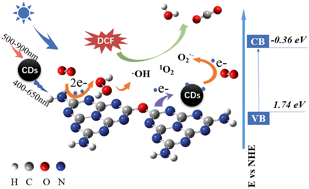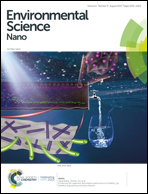Dual metal-free polymer reactive sites for the efficient degradation of diclofenac by visible light-driven oxygen reduction to superoxide radical and hydrogen peroxide†
Abstract
Hydrogen peroxide (H2O2) and superoxide radical (O2˙−) play a critical role in environmental remediation technologies. Here, we report on metal-free co-catalysts with the in situ incorporation of carbon dots (CDs) into a polymeric O and N co-linked carbon nitride (OCN) framework, which significantly enhanced the synthesis of H2O2 and O2˙− due to dual reactive sites. For the photocatalytic degradation of a typical pharmaceutical and personal care product (PPCP), CDs/OCN demonstrated excellent photocatalytic performance in contrast to g-C3N4 and OCN, which was 11.6 times that of pure g-C3N4. The trapping experiment has shown that O2˙− plays an important role in the degradation of DCF. CDs/OCN exhibited higher electron–hole separation efficiencies than g-C3N4 and OCN, as the result of the excellent transfer and storage performance of the CDs. The yield of H2O2 generation by CDs/OCN was higher than that by g-C3N4 and OCN. Meanwhile, the electron paramagnetic resonance (EPR) spectra revealed that additional O2˙− and ˙OH were generated via the CDs/OCN system. Density functional theory (DFT) and Raman spectroscopy analyses revealed the presence of CD/OCN-resident dual reactive sites, which had distinct selective oxygen reduction capacities. We observed that O2 was more prone to 2-electron reduction on OCN, whereas O2 was more easily reduced to O2˙− on the surface of CDs through the additional e− provided by OCN. This study clearly demonstrates a simple strategy for the design and synthesis of metal-free materials in the preparation of H2O2 and O2˙− toward the degradation of organic pollutants.



 Please wait while we load your content...
Please wait while we load your content...